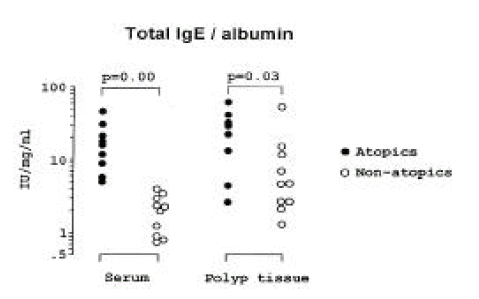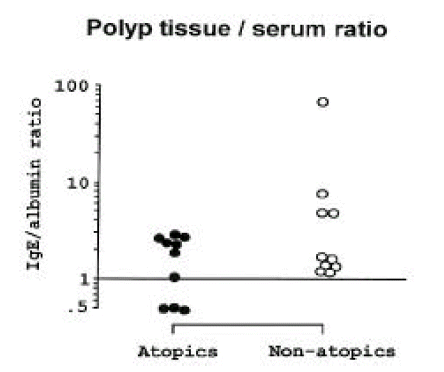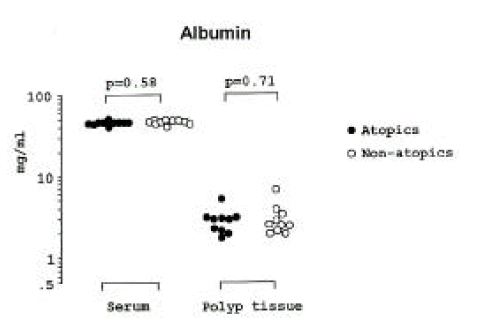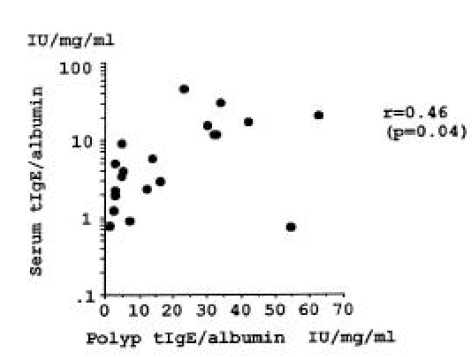IgE production from the nasal polyp tissue: Comparison between atopic and non-atopic subjects
Article information
Abstract
Objectives and Methods
To confirm the local production of IgE antibody from the nasal polyp tissue, and to evaluate the difference between atopics and non-atopics, nasal polyp tissues were taken from both 10 atopic and 10 non-atopic subjects. The tissue total IgE (tIgE) level was measured by enzyme-linked immunosorbent assay (ELISA) and serum tIgE level by radio-immunoassay. The tissue albumin level was measured by nephelometry, and serum albumin level by Bromocresol green method.
Results
The polyp tissue tIgE/albumin as well as serum tIgE/albumin ratio were significantly higher in atopics than in non-atopics (p<0.05), with no difference in the albumin level between the two groups (p>0.05). Three non-atopic subjects had high polyp tissue tIgE/albumin (>10). A significant correlation was noted between serum tIgE/albumin and polyp tIgE/albumin (r=0.46, p=0.04). The ratio of polyp tIgE/albumin to serum tIgE/albumin was greater than 1 in all of the non-atopic subjects and 7 of 10 atopic subjects.
Conclusion
These findings support the hypothesis that IgE antibody could be locally produced from the nasal polyp tissue of non-atopic subjects as well as atopic subjects. The possibility of an isolated local production of IgE antibody was suggested.
INTRODUCTION
Nasal polyps are one of the most common mass lesions encountered in the nose. Despite a long history and frequent occurrence, the pathogenesis of nasal polyp still remains to be further clarified. Although various mechanisms such as vasomotor disturbance, autonomic dysfunction, endocrine abnormalities and viral infections have been suggested as etiologic factors1–3), the two main theories most frequently mentioned are allergic and bacterial infection4). The evidence for the participation of local immunologic mechanism has been obtained in limited studies: a few studies5–7) reported the presence of a considerable amount of IgE in the nasal polyp tissue, but some authors8, 9) never or minimally detected IgE antibody.
In this study, in order to confirm the local production of IgE antibody from the nasal polyp tissue, we have performed ELISA to measure IgE antibody concentrations within the nasal polyp homogenates and compared those levels between atopic and non-atopic subjects.
PATIENTS AND METHODS
Subjects
Nasal polyp tissues were taken from random patients undergoing nasal polypectomy at the Ajou University Hospital. Atopic status were evaluated before the procedure. Allergy skin prick tests were performed on the backs of the subjects using 80 common inhalant and food allergens (Bencard Allergy Service, Brendford, Middlesex, UK). Positive response was defined on the basis that they showed more than 2+ skin-prick test reactions to two or more common inhalant allergens, such as Dermatophagoides farinae, Dermatophagoides pteronyssinus, alder, oak, rye grass, mugwort, ragweed, Aspergillus spp. Serum specific IgE antibody was determined by radioimmunoassay (DPC, USA).
Atopics were defined as those showing positive responses on skin prick (≥ 2+) and having serum specific IgE antibody to Dermatophagoides pteronyssinus. Non-atopics were defined as those who had all negative responses to common inhalant and food allergens on skin-prick test, and serum total IgE level was less than 100 IU/ml. Ten atopic and 10 non-atopic subjects were enrolled. All the subjects gave their informed consent as regulated by the Ajou University Hospital.
Preparation of the nasal polyp tissue
The polyp tissue was frozen at −70°C immediately after the operation. When prepared for the experiments, the samples were thawed, grounded in an homogenizer (POLYTRON, Switzerland) with phosphate buffered saline (PBS, pH 7.5) including 1% triton X-100. They were centrifuged and the separated supernatant had been kept at−70°C.
Measurement albumin in the nasal polyp tissue and sera
Albumin levels in the polyp tissue were measured by nephelometry10) with a Beckman Array system (Beckman instruments inc., Brea, Calf.). Serum albumin was measured By Bromocresol green method11).
Serum total IgE
Serum total IgE was measured by radio-immunoassay (DPC, USA).
Measurement of total IgE within the polyp tissue homogenate
The levels of total IgE in polyp tissue were measured by sandwich ELISA. Microtiter plates (Immulon II; Dynatech Laboratories, Inc., Chantilly, VA) were coated with affinity-purified goat anti-IgE antibody (Vector Laboratories, Inc., Burlingame, CA) at 1:500 dilution (1 mg/ml) with 0.1M carbonate, pH 9.6, for 2hours at 4°C. Plates were washed and blocked with 3% bovine serum albumin in Tween-20-PBS, and then the plates are incubated with duplicated samples (50 μ l) of polyp tissue homogenate and IgE standard (DPC, USA) diluted in blocking buffer for 2 hours at 4°C. After repeated washing, the plates were incubated with biotinylated affinity-purified goat anti-IgE antibody (Vector Laboratories, Inc., Burlingame, CA) at 1:500 dilution (1 mg/ml) for 1 hour at room temperature. After washing again, plates were incubated with streptavidin-peroxidase (0.5 mg/ml) for 30mins at room temperature. After washing, the substrate solution was added, consisting of 0.04%(w/v) O-phenylene diamine dissolved in 24.3 mM citric acid, 51.4 mM NaH2PO4 (pH 5.0) and 0.03% H2O2. After 30 min, the reaction was stopped by adding 2.5 N H2SO4. The absorbance value at 490 nm was measured by a microplate reader (Molecular device, USA). The absolute level of total IgE in the sample was calculated from the curve derived from serial dilution of IgE standard (DPC, USA). All samples were measured simultaneously to reduce the variation of measurement.
Statistics
The Mann-Whitney U-test was used to assess differences between two groups. Spearman’s rank correlation test was used to assess the correlation between two data. A p-value of less than 0.05 was considered significant.
RESULTS
Albumin level in the nasal polyp tissue and serum
Fig. 1 shows the comparison of albumin level in both serum and nasal polyp tissue between atopic and non-atopic subjects. There were no significant differences in the albumin levels between the two groups, respectively (p>0.05).
Total IgE level in the nasal polyp tissue and the ratio against serum level
When the serum total IgE level was presented as the ratio of total IgE/albumin, serum total IgE/albumin ratio was significantly higher in atopic subjects than in non-atopic subjects as shown in Fig. 2 (p=0.00). When the total IgE level in the nasal polyp tissue was presented as total IgE/tissue albumin ratio, tissue total IgE/albumin ratio was significantly higher in atopic subject than in non-atopic subject (Fig. 2; p<0.05). Three of non-atopic subjects as well as eight of atopic subjects had remarkably high tIgE/albumin (greater than 10). The ratio of tissue total IgE/albumin against serum total IgE/albumin was higher than 1 in all the non-atopic subjects and seven of 10 (70%) atopic subjects as shown in Fig. 3. Serum total IgE/albumin ratio was significantly correlated with tissue total IgE/albumin ratio (Fig. 4; r=0.46, p<0.05).

Comparison of total IgE/albumin ratio from serum and nasal polyp tissue between atopic and non-atopic subjects.

The ratio of polyp tissue-total IgE/albumin against serum-total IgE/albumin in atopic and non-atopic subjects.
DISCUSSION
The diagnosis of type I hypersensitivity has been based on the allergy skin test and RAST which demonstrate specific IgE antibodies in the skin and circulating blood. The presence of IgE to common allergens indicates that a subject is atopic, but such individuals do not always show clinical symptoms of allergy12). It has been suggested that positive skin test and circulating IgE antibody in the circulation might have a clinical significance when the patients had symptoms.
There have been several studies indicating local production of IgE antibody limited in the target tissues. Alexander13) reported four subjects having “localized allergy”, in which the subjects had a clinical history suggestive allergic diseases but negative reactions on skin-prick test to specific allergen. These patients were proved to be clinically allergic by the provocation with the causative allergen. Other investigators also have confirmed local production of allergen-specific IgE in the nasal secretion, polyp fluid in subjects with allergic and non-allergic rhinitis or nasal polyposis12, 14–21). For allergen-specific IgE antibody, house dust mite-specific IgE antibody bound to mast cells has been determined in patients whose skin test and RAST were negative for house dust mite22). These findings could be explained in two ways: one is that specific IgE comes from the blood stream and lymphocytes in the polyp tissue only from atopic patients, on the basis of positive skin test and/or serum RAST value. However, RAST and skin test are not so sensitive to detect minimal amounts of IgE. The other possibility is that specific IgE could be locally produced, which makes detection earlier than in sera where locally produced IgE overflow, as suggested by Small et al.23). In this study, although there were no differences in the tissue albumin levels, there were significant differences in IgE/albumin ratio between atopic and non-atopic subjects. Moreover, three of non-atopic subjects as well as atopic subjects had remarkably high tIgE/albumin ratio. These findings suggested that IgE antibody detected in this study might be derived from the nasal polyp tissue and the possibility of an isolated local production of IgE antibody was suggested in nasal polyp tissue from some non-atopic subjects.
It has been a common practice to use the albumin content as a marker for contribution of systemic circulation to secretary protein in the nasal secretion24). Johansson and Deusch24) in particular have favored the double ratio which was derived from the ratio of tissue total IgE to tissue albumin against the ratio of serum IgE to serum albumin, as a means of assessing whether the nasal mucosa was secreting a specific antibody. If these ratios are greater than 1, it would indicate that nasal mucosa locally produced the IgE antibody, rather than passive transduction across the nasal mucosa. In this study, the double ratio was greater than 1 in all the non-atopic subjects and seven of ten atopic subjects. These results suggest that IgE antibody determined in both atopic and non-atopic subjects might be produced from the nasal polyp tissue, not derived from the systemic circulation.
In conclusion, IgE antibody could be locally produced from the nasal polyp tissue of non-atopic subjects as well as atopic subjects. Further investigations are needed to clarify the local production of allergen specific IgE in nasal polyp tissues.

